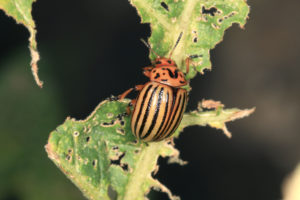The opportunity for Calantha to control CPB and benefit growers, plants and the environment
How the same technology behind personalized medicine can help agriculture, too
(Sponsored) Accounting for more than $500 million annually in crop loss worldwide, the Colorado potato beetle (CPB) can decimate plants in the nightshade family, including potatoes, and is highly prone to developing resistance to insecticides, according to GreenLight Biosciences.
GreenLight Biosciences aims to address some of the planet’s biggest challenges with a pipeline of RNA-based solutions that has the potential to benefit human, plant, and animal health. The company’s pipeline of possible agricultural RNA solutions include control of the Colorado potato beetle. The company is positioned to protect honeybees, butterflies and various crops, including potatoes – and on the human health side, it is working to develop possible messenger RNA vaccine candidates and therapeutics.

GreenLight is currently working towards commercial launch of its first potential product, Calantha, which is currently under review at and pending approval by the Environmental Protection Agency. “Calantha is a foliar insecticide that is specifically designed to control the Colorado potato beetle without having any known impact on non-target organisms,” said Brian Manley, GreenLight’s director of technical sales.
“It’s an exciting new technology based on RNA. It prevents an essential protein in the beetle from being formed, resulting in the Colorado potato beetle building up toxins in its body. In our field trials, conducted over multiple years at locations across the country, we see defoliation protection on par with industry standard products.”
Often, multiple modes of action are needed to successfully control CPB, which can be a devastating pest to potatoes across the globe. GreenLight’s RNA technology can help combat these CPB infestations and is easy to use.
Calantha works in many different environments and is easy for the grower to use. Growers mix it with water and spray the insecticide using standard agricultural practices like ground or aerial application.
The solution is designed to specifically affect the target pest. Through testing, results support that Calantha is safe for butterflies, honeybees and other non-target insects, leaving no known impact on beneficial insects or other pollinators, according to Manley.
Calantha is a new technology and a novel mode of action. The Insecticide Resistance Action Committee (IRAC) has provisionally granted a new classification for the product. Subject to EPA approval, this would bring a new tool to growers and help fight resistance among CPB populations.
Mark Singleton, general manager and chief commercial officer of GreenLight, outlined how RNA technology is beneficial in agriculture practices.
“With RNA, products can be specifically designed to target the pest that the farmer needs to be controlled without damaging beneficials that also may protect the crop. As we continue designing RNA technology, we can attack more than one species and add multiple targets, ultimately benefiting the grower,” Singleton said. “RNA technology takes the principles of integrated pest management that everyone aspires to work by and makes the process easier and more powerful.”

RNA dissipates quickly and GreenLight’s tests of Calantha show no residue when applied. According to Singleton, when RNA is sprayed, it is short-lived – meaning it does not persist more than a few days in soil or water after it is used.
“RNA is continually recycled by all living organisms which makes it more beneficial for the environment. Our process takes used biological material and recycles it into new biological material that is highly functional. Our RNA product is not heavily reliant on multiple, large quantities of solvents and raw materials,” Singleton said.
Singleton emphasizes how well Calantha fits within an integrated pest management (IPM) model because of its design to attack specific pests. GreenLight aims to bring products to the agriculture market that make sense to growers – attacking unwanted pests while not harming beneficial organisms.
“The key thing to know is that sprayable RNA is not a genetically modified organism (GMO). GreenLight has a spray that has the potential to do a lot of good for the farmer, without doing anything detrimental to the environment,” Singleton said.
Working to empower farmers and the agriculture industry, GreenLight’s ultimate goal is to grow food that is safe for human consumption and beneficial to the environment. Through research, commercialization and proper development, GreenLight can create solutions benefiting insect populations and protecting pollinators, all while maintaining water quality and soil health.
© 2023 GreenLight To learn more about GreenLight visit https://greenlightbiosciences.com/







